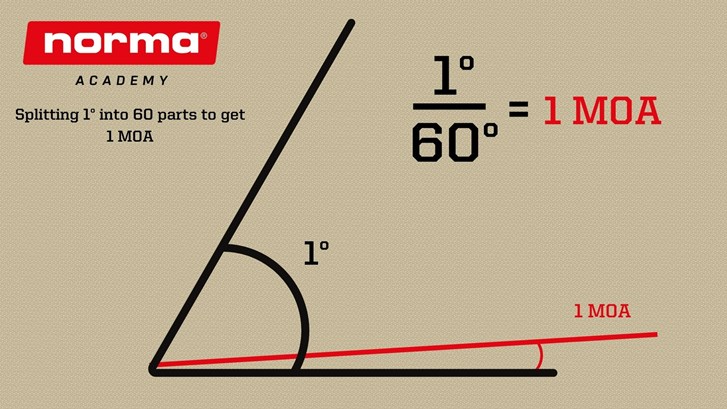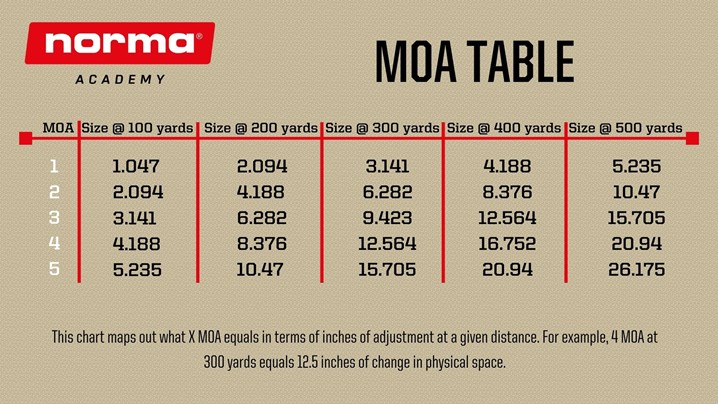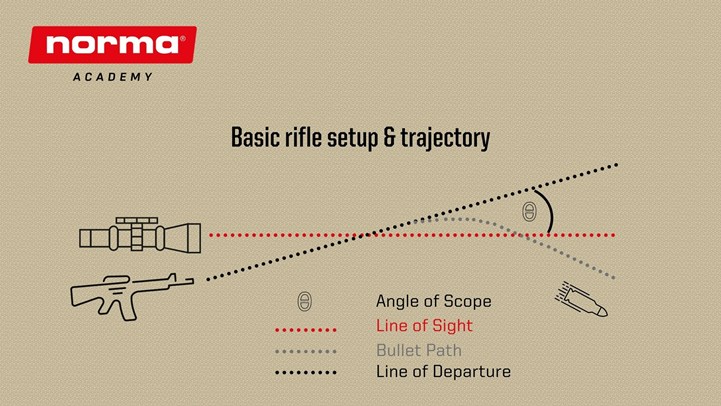What MOA is and how to use it
MOA - An Introduction
In the world of shooting, guns and ammunition there is a plethora of acronyms, technical terms and slang that can often be daunting for a beginner. In this article we are going to go over the term MOA and explain what it is, how to interpret it and most importantly how to use it for accuracy and precision in your own shots.
MOA means Minutes of Angle
The first thing to note is that the acronym MOA (pronounced by spelling out each letter) is simply a mathematical term that stands for Minute of Angle and/or Minutes of Angle in plural and is an angular measurement, just like a degree or radian. Why Minute of Angle? Well, a minute typically represents 1/60th of something, and in this case it represents 1/60th of an angular degree. To get an intuitive understanding of this, picture a circle. A circle represents 360 degrees, or think of it visually as if you were to spin around in a full turn while standing on a skateboard, that is also called "a 360". 1° of those 360° degrees is 1° degree of angle, and if you replace the word "Minute" in MOA with "1/60th" then you will see you get 1/60th of 1° degree of angle, quite simple. So when people say you need to come up, for example, 4 MOA on your rifle scope, what they are saying is that you need to change the elevation setting on your scope to angle upward at 4/60 ths of 1 degree of angle. This means that 60 MOA is 1 full angular degree (1°).

Once this understanding of the MOA-unit has settled in, the next logical conclusion is to note that MOA is quite a small unit. This fine level of granularity is helpfull for small arms users such as sport shooters or hunters that primarily want to shoot a relatively small projectile (compared to, let's say, the launch of a rocket) and counteract the drop of that projectile in relation to gravity over relatively small distances between 0-1000 yards in most cases.
There are other angular units, but MOA is a very popular one and once you understand what it is and how to use it, it will be an invaluable tool for you to master any hunting or shooting situation.
MOA - How and why it works
So now we know what MOA is, let's look at the practical application to real life hunting and shooting. The key question to understand in applying MOA in a shooting situation is to note that the angle we are measuring is the angle between your point of aim and the actual physical impact of the projectile. This can be confusing for beginners, because looking through the scope it seems as though you are aiming straight at the point of impact. But the line of sight and the barrel of your rifle are actually angled against eachother to produce a trajectory that is angled up, and then falls toward to the point of impact as gravity pulls downward on the projectile. This means that the further you want to shoot, the more time the bullet has to drop and the drop actually increases exponentially. This drop of the projectile in relation to where you are aiming creates two different points that are sepparated by a distance we can measure in size (mm/inches) and an angle we can measure in MOA, in order to bring our point of aim and point of impact in line for perfect accuracy. The basic formula is one you might remember from trigonometry in school:
tan ( MOA / 60° ) = Size of Bullet Drop / Distance of Aim
or more generally:
tan θ = Opposite / Adjacent
Notice that if your bullet didn't drop and is 0, the equation would be 0 divided by whatever distance you shot at, and you get 0 MOA as a result because you do not need to make any additional adjustment: you allready hit center!

Because the MOA is a mathematical concept of geometry that just works in the same way that gravity just works, we can consider it a constant factor in our otherwise very situational and variable shooting environment. Further, 1 MOA stays 1 MOA in a potentially endless line over any distance, but the further out you take this angle, the greater the distance between the opposite and the adjacent lines that make up the angle. The table below takes different MOA measurements and shows you at 100, 200 and 300 yards what the distance between the opposite and adjacent lines are, or for a hunter/shooter, what an MOA adjustment will do to change the point of impact at that distance.
Implementing MOA adjustments on your scope
We have still not quite come full circle, no pun intended. We need to adjust our scope to match the desired MOA adjustment if we want to actually influence our shot trajectory. Most scopes will say on the actual scope itself next to the settings knob or turret how many MOA a click on the scope translates into. Then it is just a matter of dividing the MOA adjustment by the click-value of your scope. For example, let's say a scope is graded in 0.25 MOA per click and I want to adjust 1 MOA. 1 divided by 0.25 = 4 and so I would need to adjust 4 clicks to get my scope to point adjust 1 MOA.

Summary of MOA
Now that we have a basic understanding of MOA, it's time to summarize what we have learned.
- MOA stands for Minute(s) of Angle and 1 MOA equals 1/60th of 1 degree of angle.
- While the MOA value for a given angle does not change, the physical sepparation between the two lines that make up the angle increases with distance.
- This means that 1 MOA equals different sizes at different distances, for most applicable hunting ranges though a good rule of thumb is that 1 MOA equals 1 inch of adjustment in physical space.
- This helps us as hunters and shooters, as we can now calculate how much of an adjustment we need to make on our scope to hit our target at any given distance.
- For example, if I am trying to shoot at 200 yards and my bullet drops 6 inches from center, I now know that I can adjust my scope 3 MOA up to hit the target.
- Scopes have different click values and some are graded in mRAD instead of MOA, but its a matter of simply checking your scope setting and then dividing the MOA value required by the click value of your scope.